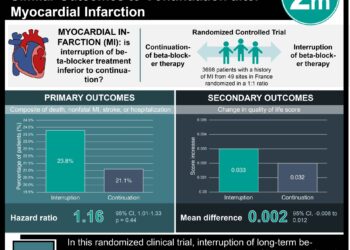TASTE trial: Thrombus aspiration before PCI in STEMI does not reduce mortality
1. Patients with STEMI who underwent coronary artery thrombus aspiration before PCI did not have a significant reduction in mortality at 1 year of follow up.
2. Patients with STEMI who underwent thrombus aspiration before PCI did not have a significant reduction in the incidence of the composite of death, re-hospitalization for myocardial infarction, or stent thrombosis at 1 year.
Evidence Rating Level: 1 (Excellent)
Study Rundown: Previous research has shown that coronary-artery thrombus aspiration in ST segment elevation myocardial infarctions (STEMIs) before percutaneous coronary intervention (PCI) reduces the thrombus burden and improves ST-segment resolution and coronary flow. However, there have been no adequately powered randomized control studies that have shown improvement in short-term or long-term clinical outcomes. The Thrombus Aspiration in ST-Elevation Myocardial Infarction in Scandinavia (TASTE) trial had previously showed no significant reduction in mortality at 30 days of follow-up.
This study presented long-term follow-up data on 7,244 patients with STEMI from the TASTE trial. Patients with STEMI were randomized after angiography either to receive thrombus-aspiration and PCI, or to undergo PCI only. There was no significant reduction in death from any cause at 1 year between the groups; additionally, there was no significant reduction in the rate of re-hospitalization at 1 year or the incidence of the composite of death, re-hospitalization for myocardial infarction, or stent thrombosis at 1 year. These comparisons remained non-significant when the data was analyzed for the full extent of follow-up (maximum 1,416 days).
The strength of this study is its use of a large randomized control study design to address a clinically relevant question in STEMI management. The results of the TASTE study argue against routine use of thrombus aspiration before PCI in STEMI, based on hard clinical outcomes. The study was strengthened by a very high follow-up rate and a low rate of cross-over between the treatment arms. Drawbacks include the fact that the results were adjudicated from a registry and the fact that the results cannot be generalized to severely ill patients who were more likely to decline study participation.
Click to read the study, published today in NEJM
Relevant Reading: Thrombus aspiration during primary percutaneous coronary intervention
Study author, Dr. Stefan K. James M.D., Ph.D., talks to 2 Minute Medicine: Department of Medical Sciences, Cardiology, and Uppsala Clinical Research Center, Uppsala University, Uppsala, Sweden
“The main finding was that routine thrombus aspiration did not reduce 1 year mortality or any other clinically important endpoints. Therefore thrombus aspiration should not be performed routinely in STEMI. It may be performed in selected cases if there is large residual thrombus burden after initial balloon dilatation. “
In-Depth [randomized controlled trial]: TASTE was a multicenter, randomized control study involving 7,244 patients with STEMI who were assigned randomly to undergo manual thrombus aspiration followed by PCI or to undergo PCI alone. End points were adjudicated from a registry and extended previous findings at 30 days to a longer follow-up of 1 year. Patients were diagnosed with an acute STEMI based on EKG changes; exclusion criteria included urgent need for coronary artery bypass surgery and an inability to provide oral informed consent (most often due to severe medical condition (37.6% of patients). Patients underwent randomization after angiography.
In intention-to-treat analyses, the rate of death from any cause at 1 year was 5.3% in the thrombus-aspiration group compared with 5.6% in the PCI-only group (HR 0.94; 95% CI 0.78 to 1.15, P=0.57). The rate of re-hospitalization at 1 year between the groups was also non-significant (P=0.81), as were the rates of stent thrombosis at 1 year (P=0.51), the incidence of the composite of death, re-hospitalization for myocardial infarction, or stent thrombosis (HR 0.94, 95%CI 0.80 to 1.11, P=0.48). Patients who were not enrolled in TASTE (37.6% because of severe medical conditions, 16.0% because of an inability to perform thrombus aspiration for anatomical reasons, 11.3% because of a judgment that thrombus aspiration was inappropriate) had a higher proportion of risk indicators than enrolled patients and in general had higher rates of negative outcomes compared to patients who were enrolled; however, outcomes were similar in patients who underwent thrombus aspiration and in those treated with PCI alone among the unenrolled group. When the entire follow-up period was considered (maximum 1,416 days), there was no significant difference in the rate of death in the thrombus-aspiration group compared to the PCI-only group (P=0.40).
More from this author: Tofacitinib superior to methotrexate monotherapy for rheumatoid arthritis, Gene mutation associated with antimalarial resistance across Southeast Asia, Moderate sodium intake optimal for cardiovascular health, Transfusion therapy linked with reduced neurovascular disease in sickle cell anemia, Severe subtype of acute lymphoblastic leukemia susceptible to FDA-approved kinase inhibitors
Image: CC/Wiki
©2012-2014 2minutemedicine.com. All rights reserved. No works may be reproduced without expressed written consent from 2minutemedicine.com. Disclaimer: We present factual information directly from peer reviewed medical journals. No post should be construed as medical advice and is not intended as such by the authors, editors, staff or by 2minutemedicine.com. PLEASE SEE A HEALTHCARE PROVIDER IN YOUR AREA IF YOU SEEK MEDICAL ADVICE OF ANY SORT.






